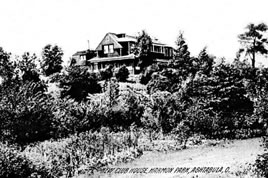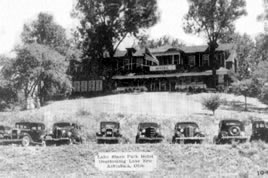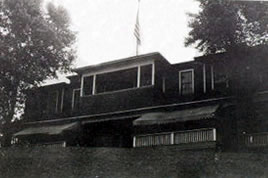|
|
|
|
|
| |
|
| |
|
A
HISTORY OF THE ASHTABULA PARK SYSTEM |
| |
Editors Note: Joel E. Melin compiled and submitted this excerpted history on July 17, 1973. We have chosen to include negative
commentary about the state of the park system in 1973 to demonstrate how our park system is dependent on the community support it receives.
The Ashtabula Township Park System was set up for the people it serves to provide a place for recreational activities with a growing urban area. From it's conception in 1906 through to the present date the park system has grown both in area and value to the surrounding community. It is the history of this development that will concern this paper. Although the records are scanty, a picture can be traced following the phases of expansion of the Ashtabula Township Park System into the community resource it is today.
Under an act of the state legislature passed on April 25, 1904, the Common Pleas Court of Ashtabula County was entitled “to authorize any township to establish a free public park.” The Common Pleas Court of this county did this is 1906 when the first commissioners were appointed for the September term of that year. The three men that made up this first commission were: H. M. Kunkle, B. B. Seymour, and F. J. Munsell. An election was then held as provided in the previously mentioned law, with the tally of the votes showing favor for the establishment of such a park commission.
|
| |
 |
 |
| |
The first meeting held by the newly created park commission took place on June 26, 1906. At this meeting elections were held and J. F. Hunkle was made president, B. B. Seymour, treasurer, and J. F. Munsell, secretary. Also, a passing vote was given to a levy of taxes at a rate of 8/10 of a mill. The commission hired landscape architect Volney Rogers (designer of Mill Creek Park in Youngstown) to find a suitable location for the parks. Mr. Rogers had studied the area in December of 1905 and again returned in June of the next year. Making his report to the commissioners in September 1906, he recommended the present Lake Shore Park, then known as Harmon Park.
On October 1, 1906 a vote was ordered on the question of issuing bonds for $25,000 to purchase and improve Harmon Park, but was defeated at the election. The first money received by the park commission was the December installment of taxes for the tax year 1906, amounting to $2,579.92, from the County Auditor. It was not until November 7, 1908 that the first land was purchased. It was the Frank Adams and Howard Knox property, which was on Main Street, nearly opposite Sycamore Street. This was the beginning of what has now become known as Indian Trails Park. By December 26, 1908 more land in the gulf of the Ashtabula River was acquired from Mary A. and C. O. Smith, A. H. Morgan, and L. J. Fargo. Price for this land ranged from $ 1,000 to $5,000 with some donated.
On January 1, 1910 the park commission began to work on the project of a lakeside park. They authorized “to enter into negotiations for the purchase of a park on Lake Erie and to be named as the properties considered.” In March 1910, Mr. Munsell resigned from the commission, as he held legal title to some of the lands along the lake that were being considered. He was replaced by Dr. I. H. Pardee. On April 18, 1910 purchase of Harmon Park with 2, 542 feet of lake frontage and about 50 acres of land was authorized for $15, 000.
|
| |
 |
| |
From May 1910 to 1913 the park commission was jumbled around. Mr. Seymour left because he was a non-resident of the township, and Mr. Munsell was reseated. Later, E. P. Hall replaced Munsell due to illness, but resigned after one year and once again Munsell assumed duties. The commission stayed set like this for the next several years with Pardee and Kunkle in the other seats.
In March 1913 and September 1914, the homes of H. K. Kunkle and Mr. Starkey were purchased along Walnut Street with a total of 378 feet of frontage and extending north to Lake Erie. This was to become the beginning of what is today Walnut Beach Park, where July 1, 1919 a bath house and restroom facilities were built according to plans by John L. Wilson, architect, at a cost of $5,345. The Starkey home was turned over to the Harbor Women’s Community Club on September 20, 1920 under written contract. The club was to be in charge of the place and was described as being a “very pleasant meeting place.”
Also during this time changes were occurring on the landscape of the present Lake Shore Park, as it was slowly being developed. In the spring of 1914, the architect, Mr. Rogers, and civil engineer, Harry Rell, laid out roads at the park and by the fall of 1916 were completed. At the idea of W. J. Kunkle, on September 18, 1919, the first foundations for the large pavilion at the park were poured. J. L. Wilson was the architect and MR. Kunkle was employed as the head of construction. It was decided that a basement should be built under the entire building “so that the public might have an ideal picnic place.” Built largely out of cement, the pavilion measures 24 feet wide and 440 feet long, at a cost of $40,000, but according to its builders “should stand the wear of long years.” The building was furnished with tables, seats, and swings. Flood lights were placed on the top of the building to “make bathing even more pleasant in the evening than daylight.” Also a contract was awarded to E. L. King for bathing outfits and refreshments, both at Walnut Beach and Lake Shore Park.
During these beginning years from 1905 to January 1921, cost to purchase, improve and operate the infant park system ran to $137,707.30. The initial credit for getting the ball rolling has been given to MR. J. F. Munse, and as a result he received the nickname, “The Father of our Township Parks.” Credit should also be given to the other commissioners who “worked without pay and paid their own expenses.” Without their dedication during these rough early years, the park system might never have taken hold. In a report made by State Examiner John Hoegner in 1916, he congratulated Ashtabula Township “upon securing so much park space while the price was within reach of the people. It will not only grow in value, but will be a blessing to the people meanwhile.” The park system of Ashtabula Township thus was born.
|
| |
| |
The next phase in the park system goes through the development of the lands. In April of 1922, Adolph Johnson made the Old Club House (so-called) into a modern home to be occupied by the park caretaker at a price of $2,000. The Lake Shore Hotel was situated on top of the hill, where the newest of the little pavilions is located along East 1st Street. In the gulf, more land was being acquired near the Spring Street Bridge, bought form L. L. Van Vleck, E. E. Whitman, Julia E. Fassett, and J. Van Aken, ranging from $1,000 to $5,980.50. In April 1929, Viril T. Hogue was hired as a landscape architect for the park system. In May the same year, Walnut Beach Park was leased to the city Ashtabula for five years at $1.00 per year and at the option of the city to be continued five years longer.
The years 1929 to 1932 brought many changes to the scenery of the park system. Road construction was continued and improved. Also, rest stations were planned and built. In April 1930, one car of stone steps and three cars of broad leaved evergreens were purchased and distributed throughout the parks. Dirt from the excavation for the People’s Building and Loan Company was placed along Valley View Boulevard during the summer of 1930, and was graded and seeded. In the same year, smaller pavilions on the eastern reaches of Lake Shore Park were built and also the refreshment stand was constructed by the Laird Brothers Construction Company and M. J. Warren, respectively. Also on April 17, 1931, a pair of swans was bought for $60 to go along with the ducks donated by Richard Wyman of Saybrook “and you can hardly ever go to the Lake Shore Park winter or summer and not see autos parked by the ponds watching them.” The gulf system grew with the addition of the G. M. Brown farm in 1931. It extended north to the New York Central Railway and is primarily the area now occupied by the Little League Park. September 1932 saw the last major improvement to Lake Shore Park. At this time block was purchased and set in place to make a wall along the lake front. This has become the pier from which many fishermen have chanced their luck with the fish of Lake Erie.
The development rendered to the growing township park came more or less to a standstill at this time. By May 1, 1933, this growth had cost $78,644.61 more and now entailed 385.59 acres. Since this time, the only major growth and change has taken place in the gulf area, where gradually more land has been added. Otherwise Lake Shore Park is laid out the same as in 1933.
The last phase in the history of the township parks brings things to the present and runs through the minor changes in this period. Perhaps most interesting is the part played by the CCC (Civilian Conservation Corp). Through the years 1935 and 1936 this group was camped at the site where Cedarquist Little League Park is today. These men carried out most of the changes left to be made in the parks. They helped in road construction in the gulf, with the finishing of the fishing pier, in the making of the rock garden of Lake Shore Park and in general shaping up the appearance of the lands. They, in fact, leveled a small hill located behind the playground along the shore and used the dirt to help build up the pier.
In 1950, the Lake Shore Hotel was torn down as a result of a lack of business. In its place the newest of the pavilions was constructed late in the 50’s. The only other building to have take place in recent years was that of a small overlook facing Pinney Dock and restroom facilities in the gulf area. For one year in the late 50’s a roller skating arena and amusement type setup was located near the present playground, but was there for just one summer.
|
| |
| |
The gulf region of Indian Trails Park, as it is known now, covers 369 acres as it stretches from the Penn Central Railway in the north to the National Guard rifle range in the south, winding its way with the Ashtabula River. Since the advent of new roads, it has stayed pretty much a natural area. Previously, when State Road was a main byway and when the road to Main Street followed along East 51st Street through a covered bridge in the gulf, a lot of traffic passed through the area. The little league park had its beginnings in 1949 when the first ball field was constructed there. Since that time, it has grown, but in fact is not under the township’s control. The group is allowed to use the land for its purpose on the condition it maintains the area. The archery club operates under the same setup. The grounds for camping trailers were first established in 1968. The purpose was simple to provide revenue for the maintenance of the lands.
The lake front property of the township parks become solely Lake Shore Park in 1953 when the Walnut Beach portion was sold to the city. At the park a few other minor things were changing. The baseball field, which was built out of an apple orchard in the 20’s, has served for many softball leagues and as a result bleachers were built for the spectators. Boaters have been served since 1949, when Dominic Dotti established a boat rental or lease from the township. This has changed hands to a Mr. Kegel and finally to Elmer Gideon, who was forced to close in this spring of 1973 due to damages by the high water of Lake Erie. Still operating, though, is the Outdoor Boating Club of Ashtabula, at the west end of the park, which has facilities for launching. In 1960, peacocks were introduced as an attraction. Since then, the area on the hill adjacent to the large duck pond has been fenced in and whitetail deer and various other animals have become interests for visiting tourists.
In the past ten years or so the whole Ashtabula Township Park System has fallen slowly into a state of disrepair. Under the guidance of present superintendent John Wipula, every year the park system has been kept open and available to the public. Lack of money with a resulting manpower shortage and outdated equipment has not allowed for the upkeep necessary to maintain the battle with the elements and demands of the community. As a result, areas like the rock garden, sidewalks and steps and the duck ponds have gradually deteriorated in the park and in the gulf. Trails and picnic sites have fallen victim to the undergrowth. Lake Erie also has begun taking her toll along the waterfront. With the recent high water, already the fishing pier has collapsed in places and is under water in others, and the beach area as been greatly reduced and devastated. Now with only a mere 20 or 30 feet to protect it, the large pavilion in the park is in great danger from the elements and violent storms of the lake.
Back to top.
| |
|
|
|
|
© Copyright 2005–, Ashtabula Township Park Commission |
|